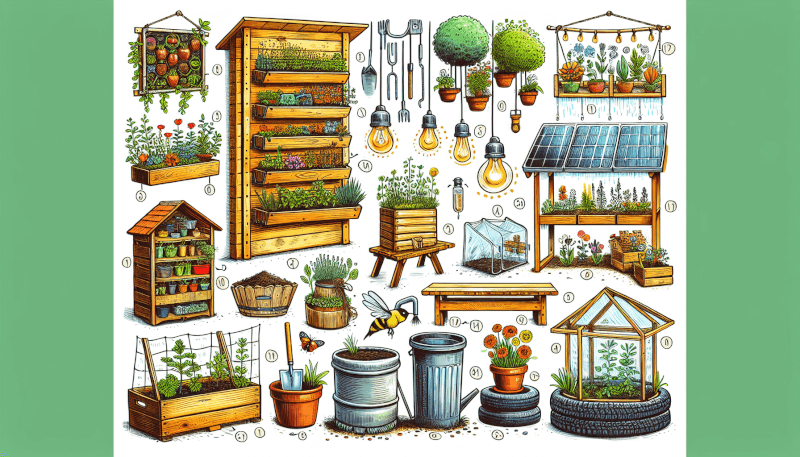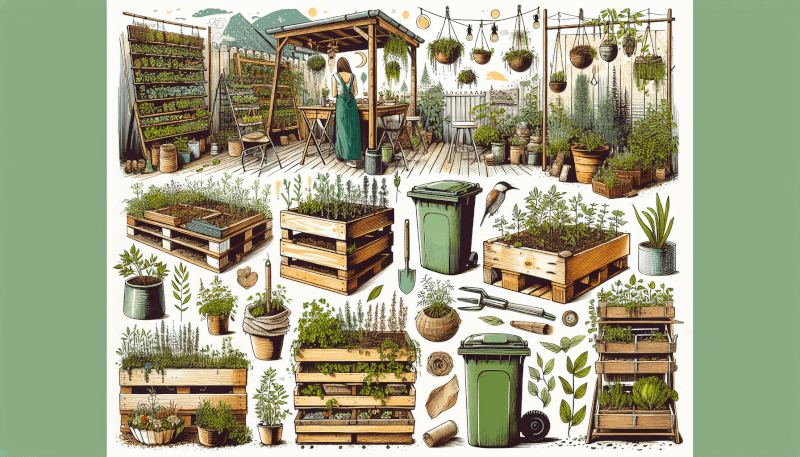Imagine transforming your garden into a sustainable haven, where you can grow your own fresh produce and create an eco-friendly oasis right at home. In this article, discover 10 exciting DIY garden projects that will not only spruce up your outdoor space but also contribute to a more sustainable lifestyle. From building your own raised garden beds to constructing a rainwater harvesting system, these projects are sure to inspire and empower you to create a greener, more environmentally conscious garden. So grab your gardening gloves and get ready to embark on a journey towards a more sustainable future.

Composting
Composting is a fantastic way to turn your kitchen scraps and yard waste into nutrient-rich soil for your garden. By creating a compost bin, you can easily collect and break down organic materials, transforming them into a valuable resource for your plants. To create a compost bin, you can use a variety of materials such as wooden pallets, chicken wire, or even repurposed containers. Simply construct a container that allows for proper airflow and drainage while keeping pests out. It’s important to choose the right compost materials, such as fruit and vegetable scraps, coffee grounds, eggshells, and grass clippings. Avoid adding meat, dairy products, and oily foods as they can attract pests and slow down the decomposition process. Turning and maintaining the compost pile is crucial for successful composting. Regularly turn the pile with a garden fork to aerate it and speed up decomposition. It is also essential to keep the compost pile moist but not overly wet.
Rainwater Harvesting
Collecting rainwater is an eco-friendly way to reduce water consumption in your garden and take advantage of natural resources. Installing rain barrels is a great way to start rainwater harvesting. Place the barrels underneath your downspouts to collect rainwater from your roof. Make sure to cover the barrels with tight-fitting lids to prevent mosquito breeding and reduce evaporation. Another great way to utilize rainwater is by creating a rain garden. A rain garden is a specially designed garden bed that captures and filters rainwater, allowing it to soak into the ground slowly. Choose an area in your yard where rainwater naturally collects or create a depression to collect the water. Fill the rain garden with native plants that can tolerate both wet and dry conditions. Lastly, consider using a drip irrigation system to maximize water efficiency in your garden. A drip irrigation system delivers water directly to the plant’s roots, reducing water wastage and promoting healthy plant growth.
Planting Native Species
Planting native species in your garden is not only beneficial for the environment but also adds beauty and diversity to your outdoor space. Before selecting native plants, it’s crucial to research which plants are native to your specific region. Native plants are adapted to local conditions, require less water, and support local wildlife. When designing a native plant garden, consider the plant’s mature size, sun exposure, and soil type requirements. Group plants with similar needs together to ensure they thrive in their designated areas. Creating habitat for local wildlife is another essential aspect of planting native species. Incorporate birdhouses, butterfly feeders, and ponds in your garden to provide shelter, food, and water for native wildlife.
Building Raised Beds
Raised beds are a fantastic option for growing plants in areas with poor soil quality or limited space. When choosing the right location for your raised beds, look for an area with ample sunlight and easy accessibility. The construction of raised bed frames can be done using various materials such as wood, concrete blocks, or metal. Ensure that the frames are sturdy and level to provide stability for the soil within. Filling the beds with organic soil is crucial for the success of your plants. Use a mixture of garden soil, compost, and other organic amendments to create a nutrient-rich environment. Raised beds also provide excellent drainage, preventing waterlogging and root rot.

DIY Greenhouses
If you want to extend your growing season or protect delicate plants, building a small greenhouse is an excellent solution. Choose materials such as PVC pipes or wooden frames to construct the greenhouse structure. Cover the frame with clear plastic or greenhouse-grade polycarbonate panels to create a suitable growing environment. Proper ventilation and temperature control are essential for maintaining a healthy greenhouse. Install vents or windows that can be opened and closed as needed to regulate airflow and temperature. Additionally, consider using shade cloth during hot summer months to prevent overheating.
Vertical Gardening
Vertical gardening is a space-saving technique that allows you to grow plants vertically rather than horizontally. Constructing a vertical garden structure can be done using materials such as trellises, pallets, or hanging baskets. Attach the structure securely to a wall, fence, or other sturdy support. When choosing suitable plants for vertical gardening, consider their size, weight, and growth habit. Vining plants like tomatoes, cucumbers, and beans are excellent choices for vertical gardens. Regular maintenance of vertical garden systems is crucial to ensure healthy plant growth. Monitor the plants regularly for any signs of pests or diseases and provide proper support as the plants grow.

Natural Pest Control
Creating a beneficial insect habitat is an effective and eco-friendly way to control pests in your garden. By attracting beneficial insects like ladybugs, lacewings, and bees, you can naturally keep pests at bay. Plant native flowers with small, shallow blooms to provide nectar and pollen for these beneficial insects. Additionally, using organic pest control methods can help manage unwanted pests without harming the environment. Options include using insecticidal soaps, homemade vinegar sprays, or introducing natural predators like praying mantises or ladybugs. Another effective strategy is planting companion flowers and herbs. Certain companion plants repel pests, mask the scent of susceptible plants, or attract beneficial insects. For example, marigolds can help deter aphids, while basil can repel mosquitoes.
Herb and Vegetable Container Gardens
Growing herbs and vegetables in containers is a versatile option for gardeners with limited space or a desire for mobility. When selecting containers, choose ones that are the appropriate size for the plant’s root system. Ensure that the containers have adequate drainage holes to prevent waterlogging. Certain herbs and vegetables thrive in containers, such as basil, thyme, lettuce, and tomatoes. Provide proper care and maintenance by regularly watering, fertilizing, and monitoring for pests and diseases. Rotate the containers periodically to ensure all sides of the plants receive adequate sunlight.

DIY Compost Tea
Compost tea is a natural fertilizer that enriches the soil and provides essential nutrients to your plants. Making a compost tea brewer is relatively simple and requires a few basic materials. Construct a brewing container using a food-grade container with a tight-fitting lid and aeration system, such as an aquarium pump or air stones. Fill the brewing container with water and add well-aged compost. Allow the mixture to brew for 24-48 hours, stirring occasionally. Once the brewing process is complete, strain the compost tea and use it to water your plants or as a foliar spray. Compost tea provides a concentrated dose of beneficial microorganisms and nutrients, resulting in healthier, more robust plants.
Upcycling and Repurposing
Gardening can be an opportunity to exercise your creativity and reduce waste by upcycling and repurposing materials. Get creative and turn recycled materials into unique garden art. Repurpose old car tires into vibrant flower planters or transform wine bottles into stylish garden borders. Consider using salvaged materials such as bricks, stones, or pallets for DIY garden projects like raised beds or vertical gardening structures. By upcycling and repurposing, you not only reduce landfill waste but also add a touch of personal flair to your sustainable garden.
Incorporating these ten DIY garden projects into your gardening routine can lead to a more sustainable and eco-friendly garden. Composting, rainwater harvesting, planting native species, building raised beds, constructing DIY greenhouses, vertical gardening, natural pest control, herb and vegetable container gardening, DIY compost tea, and upcycling and repurposing are all practical ways to minimize environmental impact while enjoying the beauty and abundance of your garden. So, roll up your sleeves, grab your tools, and embark on a sustainable gardening journey that will benefit both you and the planet. Happy gardening!



